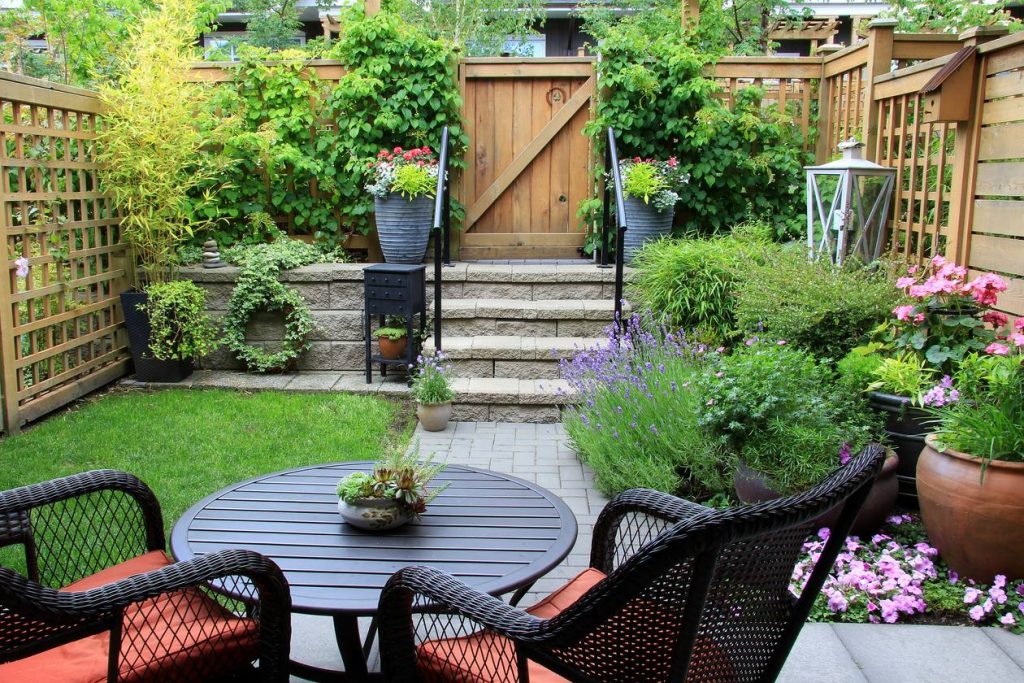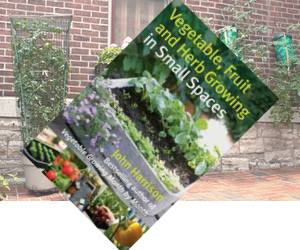An interesting article about growing in pots and how to plant container gardens from Mary Hanna. All the information you need to know on how to plant Container Gardens. This article will show you how to plant successful and healthy Container Gardens.
How to Plant Container Gardens
When you are ready to mix ingredients, be sure the soil is damp and workable. To determine this, take a handful, squeeze it and allow it to drop. If water comes out, it is too wet; if it breaks apart, it is too dry. But if the lump of soil retains its shape or cracks just a little when it is dropped, it is in good condition to work.
Be certain gardening containers are clean when you start. Soak used or new clay pots overnight so they will not draw moisture from soil after planting. This is a very important step when you are beginning your plants life. If the pot draws off the moisture the new plant will be deprived.
Though redwood, cedar, and cypress s may be left natural, they may also be stained or painted. First clean the surfaces then apply one or two coats of stain or paint. Let dry completely before planting.
Consider the shape of each, its color, and texture in relation to the color of flowers and foliage and the present as well as ultimate size of each plant. Don’t choose material that is too small, and if you want a group of plants for a large, select one tall specimen for the center to give height and scale.
Keep in mind the form of plants, particularly the evergreens which stand out boldly in winter. Rounded types, as clipped yews or globe arborvitae, look well in angulars. Hollies or yews, sheared into squares or pyramids, look better in circular tubs. This contrast of the curving with the straight always gives interest to the garden and those guests that visit.
The first step in potting a container garden is to place sufficient drainage material in the bottom of each so that water can pass through freely, but not so much as to interfere with the roots. An inch or two of flower pot pieces (rounded sides up), or chips of brick or flagstone, pebbles, gravel, small stones, or cinders can be used. The larger the pot, the larger the pieces should be. Some gardeners spread a piece of coarse burlap and a layer of sand over large drainage pieces. A layer of Vermiculite or sphagnum moss over the drainage material is also fine to keep soil from clogging holes. If the holes clog the roots will drown.
Above the drainage, spread a layer of soil, the amount depending on the size of the root ball of the plant. Place the plant in position so that the surface of the soil will be an inch (more for big plants) below the rim of the pot. This space is needed to hold water.
Fill soil in around the roots, firming gently with your fingers or a piece of wood so as to eliminate air pockets. Do not make the soil too tight for fine feeding roots must be able to penetrate it with ease.
Finally, water plants well, let them drain. If water passes through the pot very rapidly, press soil again to firm it, that means there are air pockets. If the soil holds water too long, loosen it a little.
Place the plants in a sheltered spot out of sun and wind for the first week or so while they make new root growth and adjust to new conditions.
When your permanent trees, shrubs or perennials grow too large for their pots, shift them to bigger ones. Water them the night before so the soil will be moist for transplanting and won’t cause you to tug hard to get them out. Dry soil tends to break apart, except on root-bound specimens.
Planting large specimens purchased in temporary nets is a more involved process. If they are in baskets or boxes, these can be broken or torn apart, but be careful not to disturb the roots. Tins must be opened with tin cutters. To remove plants, put the cut nets on their sides and pry steadily at the ball of soil gently in order not to break it. The less root damage the better the odds that the plant will be healthy.
All plants benefit from a mulch spread evenly over the surface of the soil. This will keep the soil cool and moist while keeping the weeds under control. Use peat moss, sand, gravel, stones, pebbles, buckwheat hulls, or Vermiculite. One of these will also give an attractive appearance but since the mulch conceals the soil, it is more difficult to determine when to water. Test by poking a finger through the material to touch the soil.
In the case of planters, again make certain drainage facilities are good. Usually there are holes at the base or sides. For best results, every four square feet should have a two-inch drainage outlet to keep those roots healthy.
Planters require day-by-day care to keep plants at their best. This means pruning, staking, spraying, feeding, and more particularly watering. Often planters are located under overhanging roofs or broad eaves. Wherever they are, do not depend on rain, but apply the hose as often as needed, which is usually daily and sometimes more often.
Useful Links in the Allotment Shop:
Wooden Planters
Potato Planters
Vegetable & Tomato Planters
Growbag Growing
Herb Planters
Wall & Vertical Planters
Decorative Pots, Planters and Stands
Container Pot & Patio Growing, Flowers, Vegetables, Fruit & Herbs – Information & Advice
- Container Gardening – Container Vegetable Growing
- Container Gardening – General Advice Guide & Tips
- Container Gardening – Protecting Your Plants & Crops From Pests
- Growing Tables for Vegetables, Fruit & Herbs
- The Basics Of How to Plant Container Gardens
- What Vegetables Can You Grow in Containers?
- Winter Care of Container Fruit Trees





